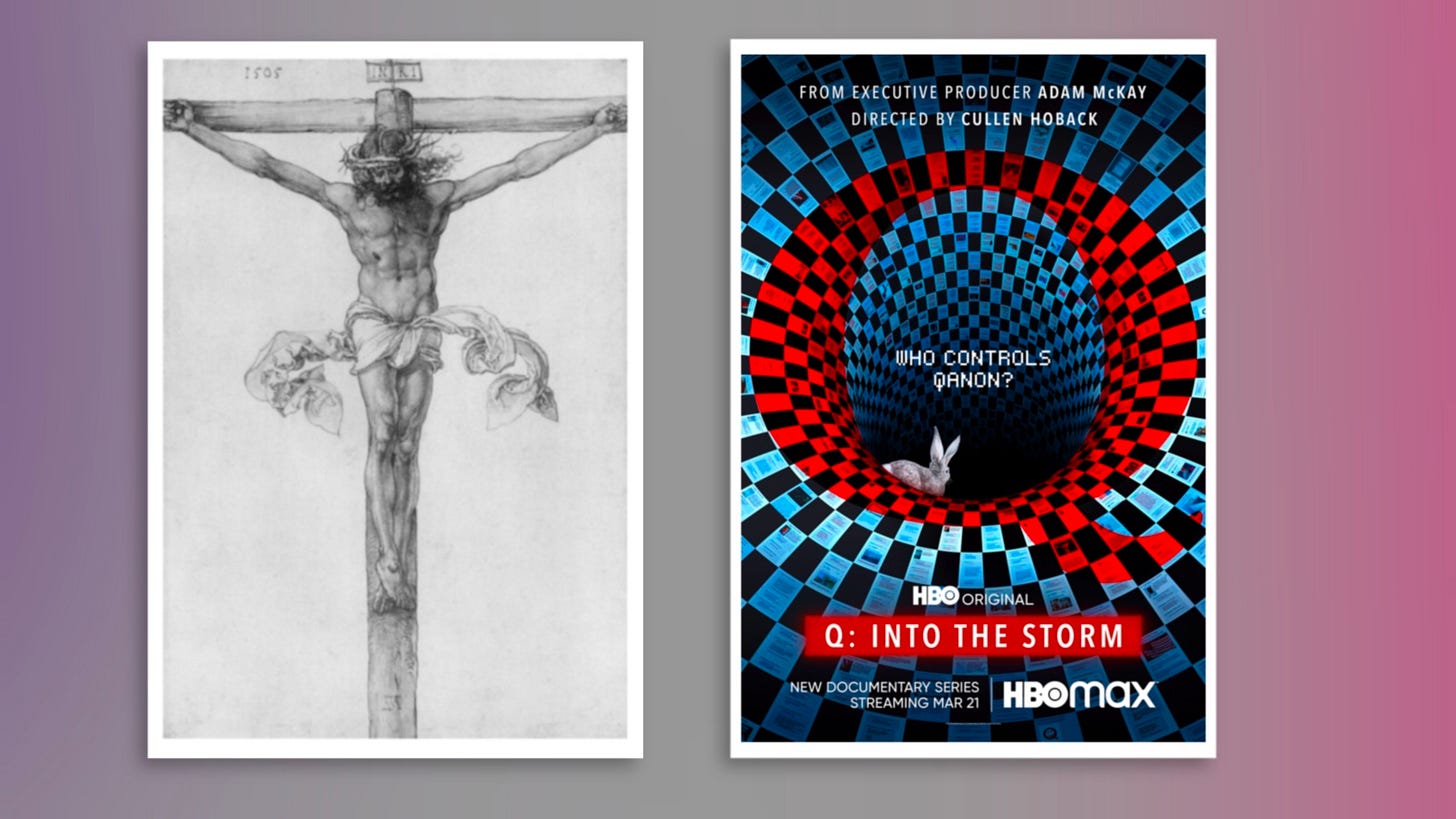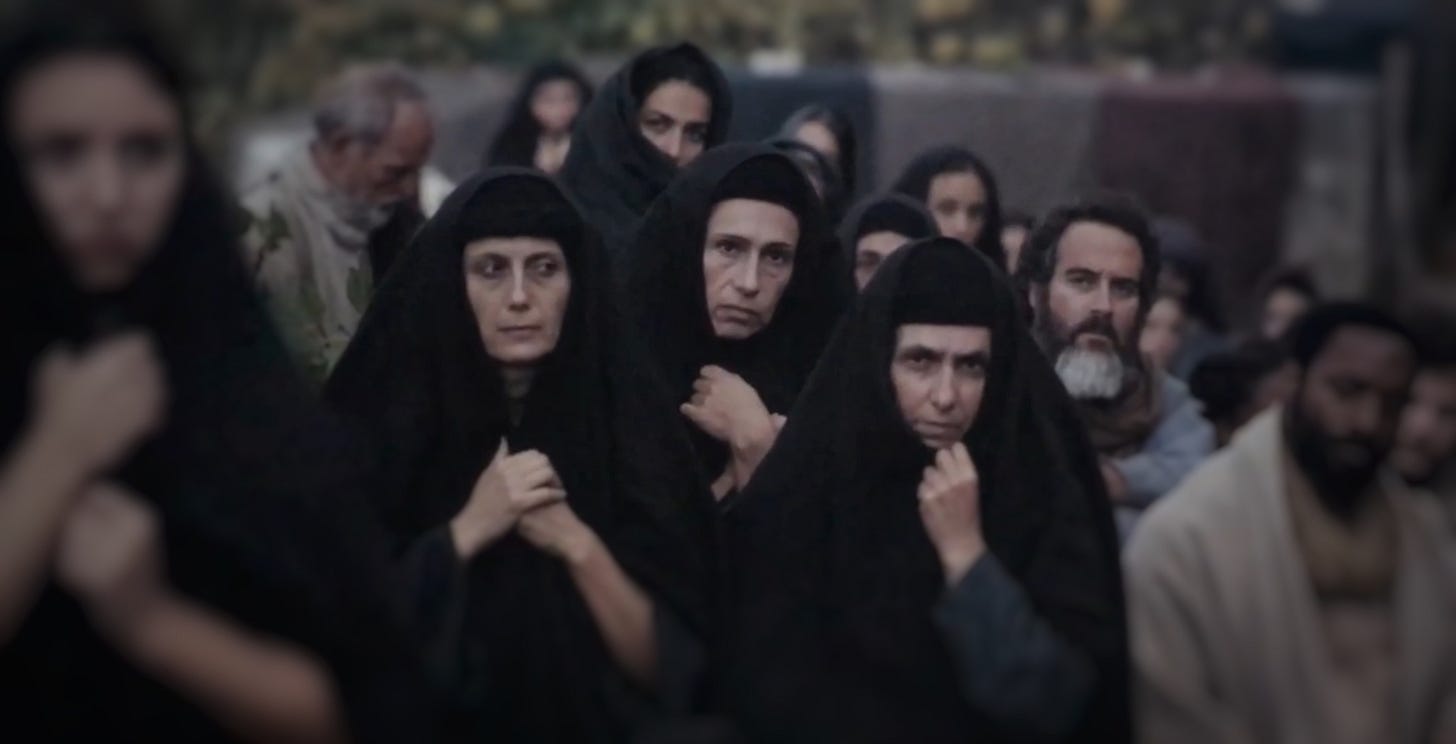Clown Christ Superstar: World Isa Stage pt 1
On Joker 2, Mahdi, and the Weaponization of Victimhood
“Twenty Seventeen”
The same year corporate media began mandating public awareness of Qanon, a curiously manufactured and bizarre conspiracy theory about a highly organized satanic pedophile ring embedded in the upper echelon of the world power elite, Oscar winning actor Joaquin Phoenix, in the 2017 film You Were Never Really Here, portrayed a psychologically scarred veteran living with his mother who’s lost almost everything and takes up work as a hired killer. His target throughout the film is an uptown pedophile dolls-house organized and connected to prominent politicians and home to abducted and abused girls. The film is bloody, disturbing, and bleak; it seems to tap into the intrinsic emotional vibration at the heart of the Qanon movement, which appeared to be generated by a gaslit co-opted collective curated from speculative chat boards originally about the very real and quantifiable disproportionate over-representation of sex offenders, pedophiles, hebephiles, and a myriad organized creepers and occultists found amongst the members and friends of Hollywood, news media, elite politicians, and royalty across western society. I first learned about international child trafficking, for instance, in a substantial article in The New Yorker about 20 years ago, while the infamous Jeffery Epstein case, as it turns out, involved elite politicians and celebrities; science popularizer and linguistics professor Stephen Pinker lent his rhetorical skills to aid Epstein in his first federal case, which he won. Later, Pinker’s friend and collaborator Bill Gates found himself in the headlines when Melinda Gates announced she was seeking divorce after finding out about his disturbingly close connection to Epstein. It seemed only a phenomena like Qanon could have made this disturbing trend seem like unreality.
Curiously, the only folks I now hear mentioning these disturbing trends in public are either the types of full fledged ‘conspiracy theorists’ constantly on board with whatever new agenda is afoot from secret world rulers or the generic motivational speaker flavored Christian pastors across the greater Denver area where I live. I’m reminded of the organic libertarian Tea Party movement from Blue State Massachusetts, also home to Ralph Nader and Jill Stein’s Green Party campaigns, and how they were transformed into a brain dead populist right wing movement after an influx of Koch Bros money and their Bible Belt bus tour. When the Green Party wouldn’t sell out they were silenced- like a politics version of the obfuscated gnostic origins of Christianity- it’s drink the kool aid or die kind of world out there, still. If early Christians were the tricorn hat centrist patriots of Massachusetts - the Roman Empire and self-anointed patristics were the Koch Bros. and friends.
Patterns Emerge
Q- The (Quelle) Source Document
The year of You Were Never Really Here’s release - 2017 - is itself a curious symbol mapping onto the overall theme of a much larger pattern map I’ve hinted at above that is the subject of this post: The repeated and gross distortion, co-opting, mockery, and weaponization of the figure of Jesus Christ in pop culture in service of fomenting a spirit of vengeance.
Basic English Gematria
When speaking of the year, we don’t say “two thousand seventeen” - we say “twenty seventeen”. The twentieth letter of the English alphabet is T, while the seventeenth is Q; so, 2017 said out loud (“living words”) embeds a homophone for the Basic English Gematria numerical value of T-Q. Here T represents the cross / crucifixion, and Q an icon for the Q Anon movement seen across media and on banners at televised Trump rallies as well as the speculated ‘Q document’ some theologians and historians believe was the original sayings gospel of Christ.
In a separate post I’ll make my case that the Gospel of Thomas, sometimes referred to as “the fifth gospel” and erroneously labeled ‘Gnostic’, is actually the speculated Q, or source (first), document from which the Synoptics and John borrow.
Here’s a peak at that Gospel of Thomas is Q work I’ll post here in the future:
Albrecht Dürer’s 1505 etching of the crucifixion of Christ & HBO’s thumbnail for the documentary Into The Storm
Don’t drop the soap…
Luke 17:2 (ESV Translation)
It would be better for him if a millstone were hung around his neck and he were cast into the sea than that he should cause one of these little ones to sin.
A couple years after You Were Never Really Here we see Phoenix, shortly before the Easter holiday, portraying Jesus in Mary Magdalene. Posters and thumbnails for the film have the tagline “HER STORY WILL BE TOLD”.
The film opens with a somewhat elegiac tone with a scene featuring a robed woman floating in the deep sea while Mara Rooney, who plays Mary, recites a version of the mustard seed parable in which an unnamed woman is the large tree sprouting from the tiny seed, possibly casting herself as the beloved disciple. Is this a bait and switch?
In the film, Mary first encounters Jesus while she’s mending fishing nets; this works as an interesting symbol for the modern women encountering distorted versions of Jesus on the internet, like the Jesus and Mohammed tandem of the curious Mahdi prophecy infecting Sunni Islam. I’ll return to these patterns and symbols later.
Occult Classic or A Cult Classic ?
For those with eyes toosie
Although the film featured three Oscar winning stars and centered - at the height of the Metoo movement - around a somewhat quasi-feminist take on the most influential religion in western society (and perhaps the world), it was curiously scantly advertised and attended - moving in and out of theaters in just a few weeks. Six months later Joaquin Phoenix starred in Joker, a gritty somewhat realistic and darkly psychological take on the infamous arch nemesis of DC Comics hero Batman. During the days of the Batman television show starring cool calm Adam West, (think Adam West as code for Adam in the Garden before expulsion eastward from Eden) the Joker was portrayed by a flamboyant and ridiculous Caesar Romero; the show itself was over the top camp. This combination of cool calm Batman and flamboyant nemesis was rebooted by Joel Schumacher in his absolutely terrible Batman and Robin - an esoterically pattern-mapped superhero dog’s breakfast version of Phantom of The Opera with George Clooney as Batman and Tommy Lee Jones as a campy over the top nemesis in Two Face. Fast forward to today’s Joker, however, and we find ourselves in a realistic Gotham of the 1980’s resembling a Martin Scorsese gangster biopic; it feels actually possible - and is a perfect example of what I’ve been calling the ‘teenageification of culture’, where adults are drawn into a world they know from childhood and adolescence that is no longer what they remember, but something darker. I’ll return to this idea of a systematic manufactured and nascent adolescent value to pop culture in a series of essays about Owen Barfield’s three stages of ‘participation’ in ‘the evolution of human consciousness’. For now it’s worth a mention the however campy Batman tv series of my youth dealt with surprisingly adult material like Cold War tensions, emergent hyper-surveillance, sophisticated geo physics, and sinister social engineering packaged for children in razzle dazzle Bang! Pow! Technicolor splendor that went unnoticed by most parents- while the new spate of massively successful and often critically acclaimed superhero films offer adult viewers a chance to retreat from an increasingly unreliable world with sexy and bold role models engaged in dark occultism and psychological detachment while consumed with a spirit of revenge (to save the world, of course). I’ll have more on that later, but a precursor to this work can be seen in my video Seduction of The Innocent:
Also important to this overall pattern is the fact the genre of modern superheroes, and the superhero comic book industry itself, was the product of Ashkenazi Jewish creators in the 1930’s, who’s first superhero was Superman - his backstory, we’re told, is a thinly veiled retelling of the story of Moses. Over the past two decades, in the wake of Michael Chabon’s Pulitzer Prize winning Cavalier and Clay, this topic has become the focus of much serious academic research - with master and doctorate degree theses written solely about the Jewish roots of Superman, superheroes, and the cultural relevance and impact this once underestimated backwater of culture has on modern society.
I’ll unpack this stuff in a separate post…
Ok, Back to the movies-
Joachim Phoenix and The Joker itself were critically acclaimed and would receive overwhelmingly positive reviews from fans as well, while - like every other Bible-themed movie ever made - Christian commentators and reviewers had major problems with a new telling of Mary Magdalene, but largely not for the reasons I’ll discuss below.
Hardheartedness: Pseudo Jesus as Moses?
In one scene Mary, by then Jesus’ regular companion, brings a group of women to Jesus who are distressed by Jewish law about divorce, unhappily married and seeking guidance from this new and controversial teacher gaining popularity for working miracles and challenging conventional law.
I couldn’t help but notice the group of women here resemble Muslims (and many are androgynous or masculine in appearance). Islam didn’t exist while Jesus was teaching, but a weaponization of Christianity by women is embedded in the film. I’ll tie it back to disturbing modern trends inserted into Islam later in this post.
Here’s the problem-
In this scene Jesus tells the women to leave their husbands.
This is nowhere in scripture, either canonical or apocryphal. It’s not in the New Testament accounts, nor is it in the often gnostic-flavored texts in which Mary Magdalene plays a more prominent roll. In fact, this scene seems to be adapted from the Old Testament story of Moses in Deuteronomy. There, Moses changes the Law of Jehovah given to him regarding divorce apparently due to ‘the hardheartedness’ of the Jewish people. Originally, according to the Law, a covenant made before God such as marriage could not be broken.
This instance of man’s alteration of Jewish Law handed down from Jehovah is cited by Valentinian teacher Ptolemy in his Letter to Flora as an example of the Jewish Law’s imperfect nature. In his letter, Ptolemy either proposed or employed several hermeneutical principles which would become commonly accepted exegetical devices in the larger ‘orthodox’ Christian church. For instance, this letter contains the first known example of the concept of apostolic succession, which the self-appointed ‘Church Fathers’ would later employ (not to mention take credit for while slandering the gnostic movement within early Christianity).
The particular problem of that time was as follows: most of the first Christians were Jews, so Scripture meant the Hebrew Scriptures. Yet, when a new set of Christian literature appeared (i.e., the sayings, letters, gospels, and everything else) and when gentiles converted to Christianity, there arose a new issue of the relationship between the Hebrew Scriptures and Christianity together with its literature. What kind of authority did the Old Testament, particularly to the Pentateuch, hold over emergent Christianity? Should the former be abandoned altogether, should it be adopted selectively according to some critical principles, or should it be read Christologically and affirmed as the Christian Scripture? Particularly, how to handle the seeming contradictions between the Hebrew Scriptures and the Christian gospel? Were these contradictions real and irreconcilable, or were they apparent and needed to be explained away? Ptolemy attempted to solve the problem by postulating Law was the work of three different types of lawgivers:
Jehovah- the just but fallible architect / demiurge of Jewish law who gave Jews the Decalogue, which was just but needed fulfillment by another (the Messiah- John 8:44).
Moses and other men - who modified the scripture with good intentions to accommodate stubborn Judeans
Demonic influence - which explains some of the heinous rules promoting the murder of non-virginal brides, race centric slavery of Goyim, and the killing of apostate children, etc.
FACE - TWO FACE
Viewing the film’s symbolism through a Valentinian (or perhaps Ptolemaic) lens, we see a bait and switch- the character portrayed by Phoenix is not based on Jesus here, but Moses, the only man in scripture either Jewish or Christian who changed Jehovah’s law regarding marriage. When we consider that Jewish authorities rejected Jesus because they were expecting a messiah of prophecy who was to liberate them from Roman rule by waging war it seems, along with the Muslim looking women in black who are disappointed with their husbands, we see a symbolically Jewish Jesus behaving like Moses. When we recall that Moses was trained in the dark arts under Pharaoh, murdered a man in Egypt, broke and changed Jehovah’s Law, and was ultimately killed and buried by Jehovah himself outside the Promiseland in Deuteronomy 34, the statements there- likely curious to most Christians who never hear about this on Sunday mornings - make perfect sense.
The closing of the Pentateuch reads:
Deuteronomy 34:4-12 (ESV translation):
And the LORD said to him, “This is the land of which I swore to Abraham, to Isaac, and to Jacob, ‘I will give it to your offspring.’ I have let you see it with your eyes, but you shall not go over there.” So Moses the servant of the LORD died there in the land of Moab, according to the word of the LORD, and he buried him in the valley in the land of Moab opposite Beth-peor; but no one knows the place of his burial to this day. Moses was 120 years old when he died. His eye was undimmed, and his vigor unabated. And the people of Israel wept for Moses in the plains of Moab thirty days. Then the days of weeping and mourning for Moses were ended.
And Joshua the son of Nun was full of the spirit of wisdom, for Moses had laid his hands on him. So the people of Israel obeyed him and did as the LORD had commanded Moses. And there has not arisen a prophet since in Israel like Moses, whom the LORD knew face to face, none like him for all the signs and the wonders that the LORD sent him to do in the land of Egypt, to Pharaoh and to all his servants and to all his land, and for all the mighty power and all the great deeds of terror that Moses did in the sight of all Israel.
So, Moses died “according to the word of the LORD” I.e., he died because LORD said so. One doesn’t need to perform Valentinian exegesis to decode what’s happening. The God of Moses (LORD) lets him get close to the finish line, enough to see it, then kills him. He’s also essentially called a terrorist here in the final line:
“…for all the mighty power and all the great deeds of terror that Moses did in the sight of all Israel.”
Fun Fact: It’s said in the Quran Allah will temporarily reward wrongdoers just to take pleasure in doubly punishing them later…
We’ll pick from here tomorrow …
End of part 1
















Hey Jason, I was wondering if you were going to do any videos, essays or podcasts on this drone situation? Sightings all over the world. Shape shifting plasma orbs? Or is it more deep fake AI? I don’t know, maybe you already did something on them and it flew over my head.
I hope to hear from you soon. Until then I’m going to read this clown Christ superstar. Merry Christmas Jason!! I hope you are doing well this holiday season.